Diving into the world of avian wonders, one bird always manages to get my attention – the Red-Wattled Lapwing. This fascinating creature is known for its distinctive red facial wattles and high-pitched call, making it a unique member of the Lapwing family.
Native to Asia, you’ll often find these intriguing birds in marshy lowlands and wet fields across the continent.
The Red-Wattled Lapwing doesn’t just stand out because of its vibrant appearance; it also has some remarkable behaviors under its wing (pun intended!). These birds are naturally territorial, displaying aggressive behavior when their nests are threatened.
Moreover, they’re known for their clever distraction techniques to lure predators away from their nests.
So why does this particular bird capture my interest? Besides being aesthetically pleasing and having an engaging behavioral repertoire, studying the Red-Wattled Lapwing gives us insight into how different species have evolved to adapt to their specific environments.
Whether you’re an avid birder or just someone with a mild curiosity about wildlife, something is captivating about these birds that’s hard not to admire.
Habitat and Distribution of the Red-Wattled Lapwing
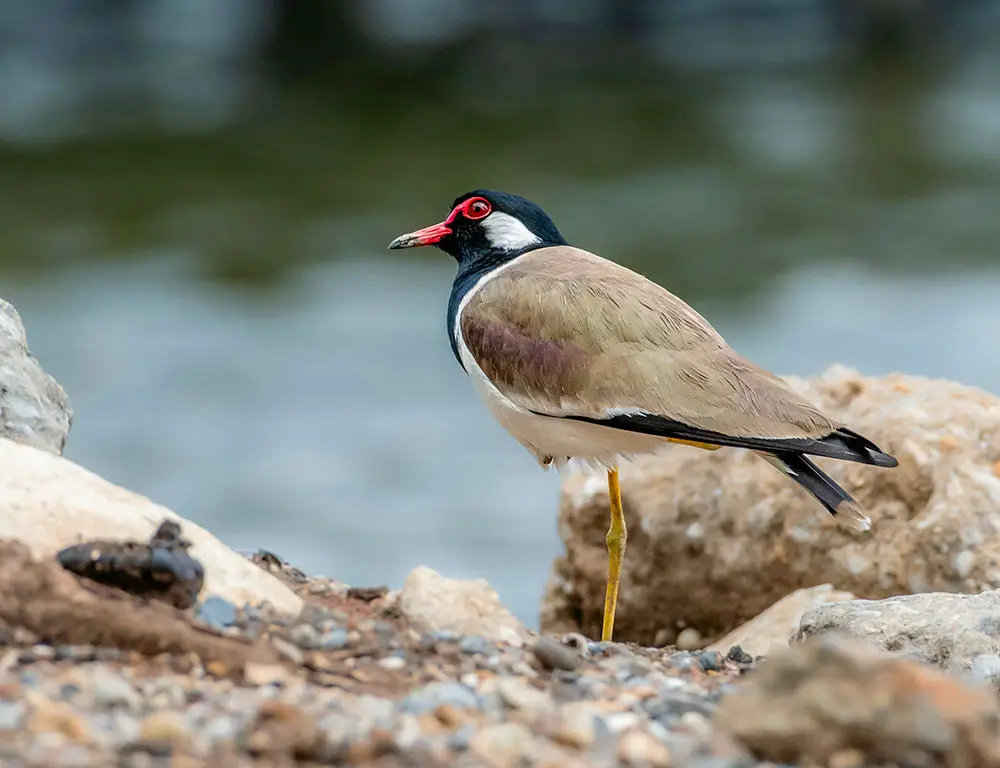
The Red-Wattled Lapwing’s habitat and distribution showcase its adaptability to various environments and widespread presence across the South, Southeast, and parts of the Middle East.
Here are the key points:
Habitat Range
Red-wattled lapwings are adaptable birds inhabiting diverse habitats, including wetlands, dry grasslands, agricultural fields, and urban parks. They can also be found in human-modified landscapes.
Geographical Distribution
Their range extends across South and Southeast Asia, with sightings commonly reported in India, Nepal, Bangladesh, Pakistan, and Sri Lanka. They have also been observed in parts of Iran, Oman, Thailand, and Cambodia.
Altitudinal Range
While they are typically found at low elevations, primarily at sea level, Red-Wattled Lapwings have been observed at heights of up to 2000 meters in the Himalayas during the summer months.
Physical Characteristics of the Red-Wattled Lapwing
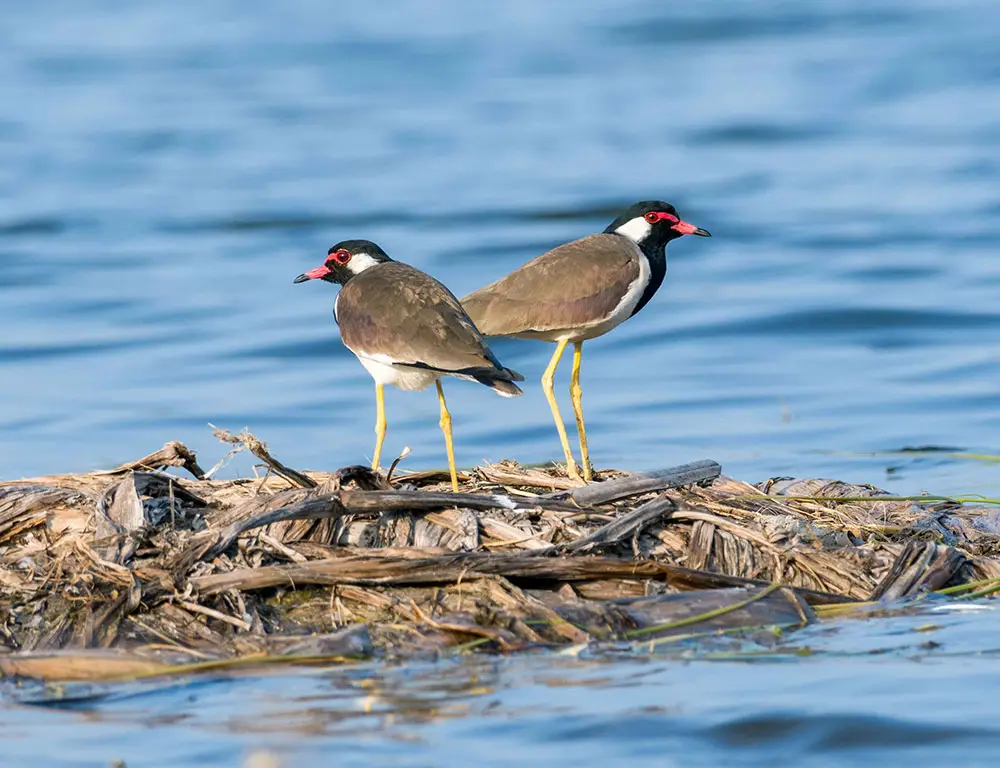
The Red-Wattled Lapwing boasts several distinctive physical characteristics that contribute to its unique appearance:
Size
An average adult Red-Wattled Lapwing typically measures 11 to 14 inches in body length, with a wingspan ranging from 26 to 31 inches. This size range gives them a sturdy yet agile build, ideal for their active lifestyle.
Plumage
Their plumage presents a captivating mix of colors, ranging from white and black to various tones of brown. Brown dominates their back and wings, while their belly and throat are predominantly white.
A distinctive black breast band further accentuates their appearance, setting them apart visually.
Facial Features
The most distinctive feature of the Red-Wattled Lapwing is its red facial wattles. These fleshy lobes hang down from either side of their beak, giving them a unique and recognizable look. It’s this striking characteristic that lends them their name.
Eyes
Their eyes are noteworthy for their bright yellow irises against a dark eye mask. This contrasting coloration adds to their visual appeal and gives them an intense gaze that captures attention when observed up close.
Behavior and Diet of the Red-Wattled Lapwing
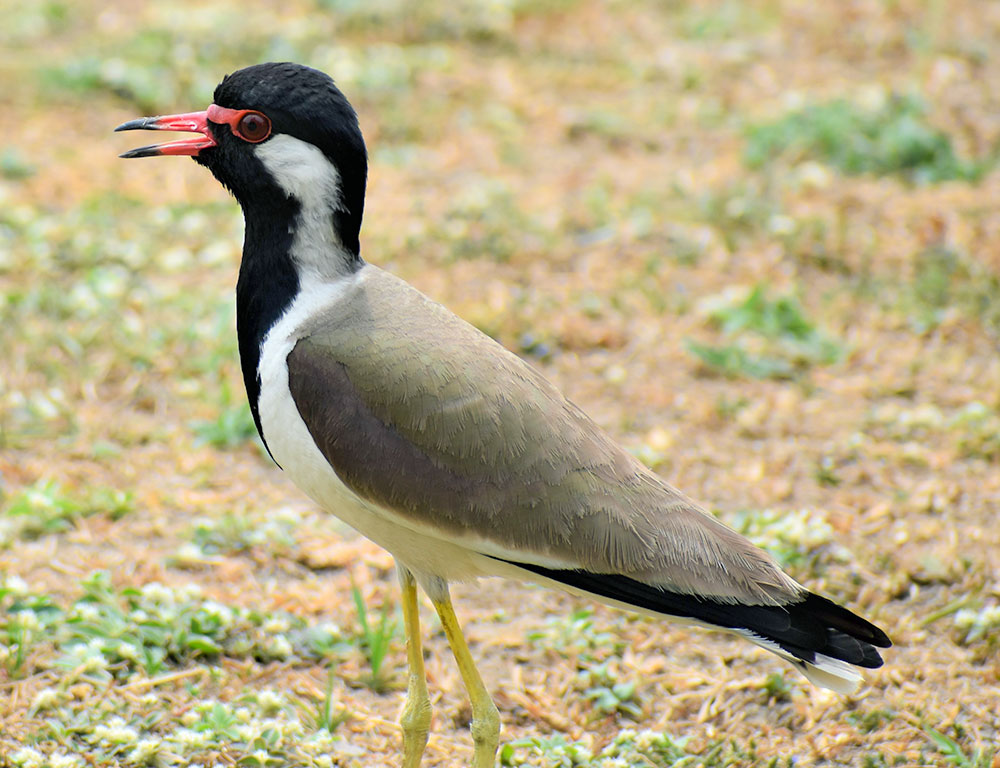
The behavior and diet of the Red-Wattled Lapwing offer a glimpse into the intriguing life of these birds:
Vocalization
Red-wattled lapwings are known for their loud and constant calls, which they use for communication and territorial defense.
Their vocal nature makes them prominent residents in their habitats, where their calls can often be heard echoing across marshes, farmlands, and urban parks.
Territoriality
These lapwings are territorial creatures, vigorously defending their habitats against intruders. Their vocalizations and aggressive displays serve as warnings to potential rivals or threats, ensuring the protection of their territories and resources.
Habitat Adaptability
Red-wattled lapwings exhibit remarkable adaptability, making themselves home in various habitats, including marshes, farmlands, and urban parks. This versatility allows them to thrive in diverse environments and utilize multiple resources for survival.
Dietary Habits
Their diet reflects their adaptability, as they have an eclectic palate consisting primarily of insects and other small invertebrates. Everyday prey items include beetles, grasshoppers, worms, and snails.
Additionally, they may occasionally consume seeds or berries when available. Their solid beaks and agile foraging behavior enable them to hunt for food on the ground efficiently.
Feeding Behavior
Interestingly, the Red-Wattled Lapwing’s feeding habits vary with the time of day and environmental conditions.
During hotter months, they may hunt under the cover of darkness to avoid extreme temperatures, while in cooler weather, they are more active during daylight hours.
This adaptive behavior ensures their survival and minimizes exposure to environmental stressors.
Reproduction Process of the Red-Wattled Lapwing
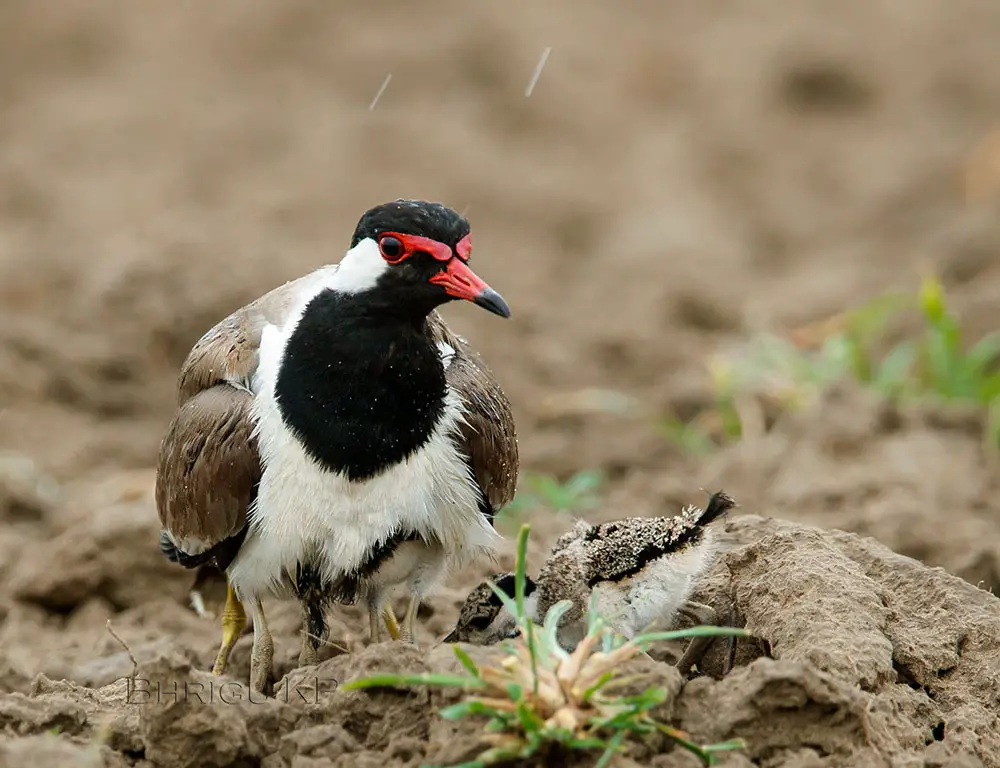
The reproduction process of the Red-Wattled Lapwing is a fascinating journey that highlights both their simplicity and sophistication:
Mating System
Red-wattled lapwings are monogamous birds, forming strong pair bonds with one partner throughout their lifetime. This commitment to one another reflects a touching display of loyalty in the natural world.
Nesting Season
The nesting season typically coincides with the onset of the wet season, providing favorable conditions for breeding. During this time, the lapwings engage in courtship rituals and prepare for the arrival of their offspring.
Type of Nest
Unlike traditional bird nests, Red-Wattled Lapwings opt for a more straightforward approach. They lay their eggs in shallow depressions on bare ground, relying on camouflage to conceal their nests from potential predators. This strategy enhances the survival chances of their offspring.
Eggs per Clutch
The female lapwing typically lays around three to four speckled eggs per clutch. Both parents carefully incubate these eggs over approximately 28 days.
Incubation Period
Both male and female lapwings take turns incubating the eggs, showcasing an egalitarian approach to parental care. This shared responsibility ensures the eggs receive adequate warmth and protection during incubation.
Chick Development
Once hatched, Red-Wattled Lapwing chicks exhibit remarkable independence compared to other bird species. They are precocial, meaning they can feed themselves shortly after birth.
However, parental guidance and protection remain crucial during this vulnerable stage of development.
Conservation Status of the Red-Wattled Lapwing
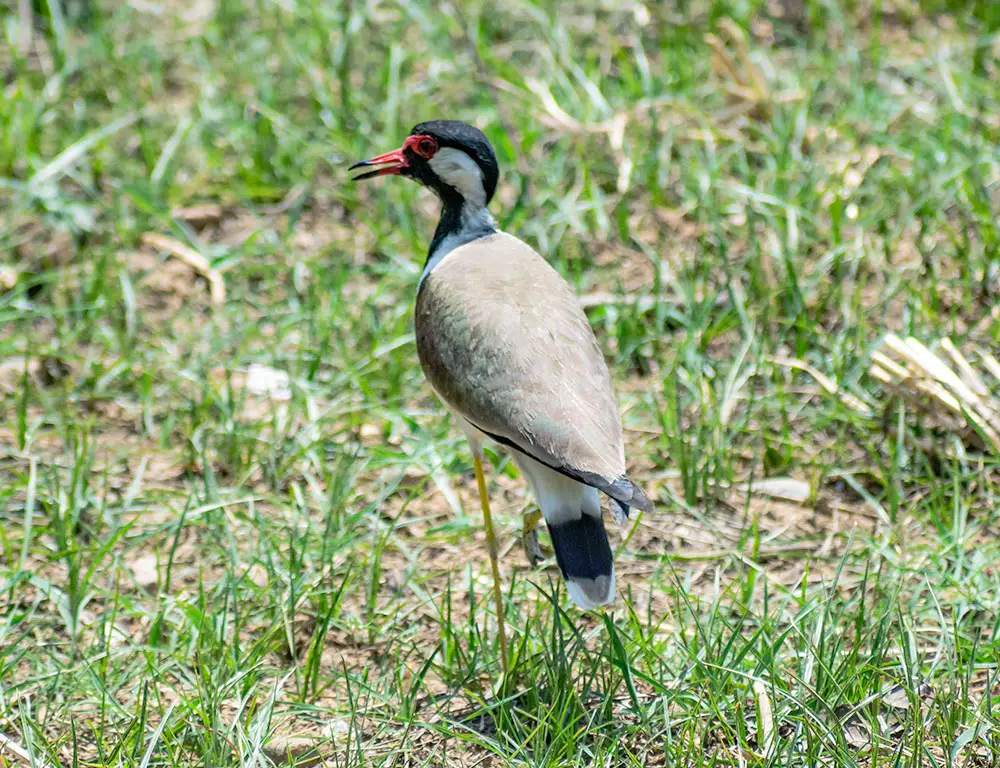
The conservation status of the Red-Wattled Lapwing, classified as ‘Least Concern’ by the International Union for Conservation of Nature (IUCN), offers a mixed picture that warrants attention and proactive measures:
‘Least Concern’ Category
The ‘Least Concern’ classification indicates that the Red-Wattled Lapwing currently enjoys a wide distribution and is relatively abundant in its natural habitats. This suggests that, at present, the species is not at immediate risk of extinction.
Habitat Threats
Despite its ‘Least Concern’ status, the Red-Wattled Lapwing faces ongoing threats to its habitats from human activities such as farming, urban development, and habitat destruction.
These activities result in habitat loss and fragmentation, which can adversely affect local populations of the species.
Population Declines
Certain regions have witnessed declines in Red-Wattled Lapwing populations over recent years. For example, Sri Lanka experienced a significant 49% decline in sightings between 2001 and 2016, while India recorded a 22% decrease over a similar timeframe.
These declines underscore the importance of monitoring and conservation efforts to mitigate further population losses.
Conservation Actions
Protecting the natural environments of Red-Wattled Lapwings is crucial for ensuring their long-term survival.
Conservation initiatives aimed at habitat preservation, restoration, and minimizing human-induced disturbances can help mitigate the impacts of habitat loss and support sustainable species populations.
Individual Contributions
Everyone can play a role in Red-Wattled Lapwing conservation by advocating for habitat protection, minimizing disturbances in their natural habitats, and supporting organizations and initiatives dedicated to avian conservation.
Simple actions such as reducing noise pollution and maintaining clean environments can also contribute to the well-being of these birds.
Conclusion
I’ve enjoyed peeling back the layers of the Red-Wattled Lapwing’s existence in this article. It’s been a journey filled with fascinating insights into this unique bird’s life, from its distinctive appearance to its intriguing behavior.
Exploring the lapwing’s habitat, we’ve seen how it thrives in diverse Asian environments. This bird can adapt to wetlands and dry regions, demonstrating awe-inspiring resilience.
However, maintaining biodiversity should always be our utmost priority. We need ongoing efforts for habitat preservation and education about species like this one.
To wrap things up:
- The Red-Wattled Lapwing is a fascinating specimen of avian species.
- This bird exhibits versatility in its habitats and unparalleled dedication to protecting its nest.
- While currently not under threat, continuous conservation efforts are essential to ensure the survival and prosperity of these birds moving forward.
My exploration of the Red-Wattled Lapwing has deepened my appreciation for nature’s complexity. It serves as another reminder that every creature is integral in maintaining equilibrium within our ecosystems.